
A scribe is a person who serves as a professional copyist, especially one who made copies of manuscripts before the invention of automatic printing.[1][2]
The work of scribes can involve copying manuscripts and other texts as well as secretarial and administrative duties such as the taking of dictation and keeping of business, judicial, and historical records for kings, nobles, temples, and cities. The profession has developed into public servants, journalists, accountants, bookkeepers, typists, and lawyers.
Scribes contributed in fundamental ways to ancient and medieval cultures, including Egypt, China, India, Persia, the Roman Empire, and medieval Europe. Both Judaism and Islam have important scribal traditions.
The profession of the scribe, previously widespread across cultures, lost most of its prominence and status with the advent of the printing press. In societies with low literacy rates, street-corner letter-writers (and readers) may still be found providing scribe service.[3]
Ancient Egypt

One of the most important professionals in ancient Egypt was a person educated in the arts of writing (both hieroglyphics and hieratic scripts, as well as the demotic script from the second half of the first millennium BCE, which was mainly used as shorthand and for commerce) and arithmetic.[4][5] Sons of scribes were brought up in the same scribal tradition, sent to school, and inherited their fathers' positions upon entering the civil service.[6]
Much of what is known about ancient Egypt is due to the activities of its scribes and the officials. But because of their ability to study in the vast Egyptian libraries, they were entrusted with jobs bigger than just copyists. Monumental buildings were erected under their supervision,[7] administrative and economic activities were documented by them, and stories from Egypt's lower classes and foreign lands survive due to scribes putting them in writing.[7]: 296
Scribes were considered part of the royal court, were not conscripted into the army, did not have to pay taxes, and were exempt from the heavy manual labor required of the lower classes (corvée labor). The scribal profession worked with painters and artisans who decorated reliefs and other building works with scenes, personages, or hieroglyphic text.

The demotic scribes used rush pens which had stems thinner than that of a reed (2 mm). The end of the rush was cut obliquely and then chewed so that the fibers became separated. The result was a short, stiff brush which was handled in the same manner as that of a calligrapher.[8]
Thoth was the god credited with the invention of writing by the ancient Egyptians. He was the scribe of the gods who held knowledge of scientific and moral laws.[9]
Egyptian and Mesopotamian functions

In addition to accountancy and governmental politicking, the scribal professions branched out into literature. The first stories were probably creation stories and religious texts. Other genres evolved, such as wisdom literature, which were collections of the philosophical sayings from wise men. These contain the earliest recordings of societal thought and exploration of ideas in some length and detail.
In Mesopotamia during the middle to late 3rd millennium BCE, the Sumerians originated some of this literature in the form of a series of debates. Among the list of Sumerian disputations is the Debate between bird and fish.[10] Other Sumerian examples include the Debate between Summer and Winter where Winter wins, and disputes between the cattle and grain, the tree and the reed, silver and copper, the pickaxe and the plough, and the millstone and the gul-gul stone.[11]
An Ancient Egyptian version is The Dispute between a man and his Ba, which comes from the Middle Kingdom period.
China
The earliest known examples of writing in China are a body of inscriptions made on bronze vessels and oracle bones during the late Shang dynasty (c. 1250 – 1050 BCE),[12][13] with the very oldest dated to c. 1200 BCE.[14][15]: 108 It was originally used for divination, with characters etched onto turtle shells to interpret cracks caused by exposure to heat. By the sixth century BCE, scribes were producing books using bamboo and wooden slips.[16] Each strip contained a single column of script, and the books were bound together with hemp, silk, or leather. China is well-known as being the place where paper was originally invented, likely by an imperial eunuch named Cai Lun in 105 CE. The invention of paper allowed for the later invention of woodblock printing, where paper was rubbed onto an inked slab to copy the characters. Despite this invention, calligraphy remained a prized skill due to the belief that "the best way to absorb the contents of a book was to copy it by hand".[16]
Chinese scribes played an instrumental role in the imperial government's civil service. During the Tang dynasty, private collections of Confucian classics began to grow. Young men hoping to join the civil service would need to pass an exam based on Confucian doctrine, and these collections, which became known as "academy libraries" were places of study. Within this merit system, owning books was a sign of status. Despite the later importance of Confucian manuscripts, they were initially heavily resisted by the Qin dynasty. Though their accounts are likely exaggerated, later scholars describe a period of book burning and scholarly suppression. This exaggeration likely stems from Han dynasty historians being steeped in Confucianism as state orthodoxy.[17]
Similarly to the west, religious texts, particularly Buddhist, were transcribed in monasteries and hidden during "times of persecution".[18] In fact, the earliest known copy of a printed book is of the Diamond Sutra dating to 868 CE, which was found alongside other manuscripts within a walled-in cave called Dunhuang.[19]
As professionals, scribes would undergo three years of training before becoming novices. The title of "scribe" was inherited from father to son. Early in their careers, they would work with local and regional governments and did not enjoy an official rank. A young scribe needed to hone their writing skills before specializing in an area like public administration or law. Archaeological evidence even points to scribes being buried with marks of their trade such as brushes, "administrative, legal, divinatory, mathematical, and medicinal texts", thus displaying a personal embodiment of their profession.[20]
Buddhism
The Buddhist Tripiṭaka emerged at the beginning of the first century. Buddhist texts were treasured and sacred throughout Asia and were written in different languages. Buddhist scribes believed that, “The act of copying them could bring a scribe closer to perfection and earn him merit.”[21]
Judaism
Scribes of ancient Israel were a literate minority in an oral based-culture. Some of them belonged to the priestly class, other scribes were the record-keepers and letter-writers in the royal palaces and administrative centers, affiliated with the ancient equivalent of professional guilds. There were no scribal schools in Israel during the early part of the Iron Age (1200–800 B.C.E.). Between the 13th and 8th centuries B.C.E., the Hebrew alphabetic system had not been developed. Only after the appearance of the Kingdom of Israel, Finkelstein points to the reign of Omri, did the scribal schools begin to develop, reaching their culmination in the time of Jeroboam II, under Mesopotamian influence.[22] The eventual standardization of the Hebrew writing system between the eighth and sixth centuries B.C.E. would presumably have given rise to codified rules and principles of language that scribes would then have learned. The education of scribes in ancient Israel was supported by the state, although some scribal arts could have been taught within a small number of families.[23] Some scribes also copied documents, but this was not necessarily part of their job.[24]

The Jewish scribes used the following rules and procedures while creating copies of the Torah and eventually other books in the Hebrew Bible.[25]
- They could only use clean animal skins, both to write on, and even to bind manuscripts.
- Each column of writing could have no less than 48, and no more than 60, lines.
- The ink must be black, and of a special recipe.
- They must say each word aloud while they were writing.
- They must wipe the pen and wash their entire bodies before writing the most Holy Name of God, YHVH, every time they wrote it. Also before they would write the Most Holy Name of God, they would wash their hands 7 times.
- There must be a review within thirty days, and if as many as three pages required corrections, the entire manuscript had to be redone.
- The letters, words, and paragraphs had to be counted, and the document became invalid if two letters touched each other. The middle paragraph, word and letter must correspond to those of the original document.
- The documents could be stored only in sacred places (synagogues, etc.).
- As no document containing God's Word could be destroyed, they were stored, or buried, in a genizah (Hebrew: "storage").

Sofer
Sofers (Jewish scribes) are among the few scribes that still do their trade by hand, writing on parchment. Renowned calligraphers, they produce the Hebrew Torah scrolls and other holy texts.
Accuracy
Until 1948, the oldest known manuscripts of the Hebrew Bible dated back to CE 895. In 1947, a shepherd boy discovered some scrolls dated between 100 BCE and CE 100, inside a cave west of the Dead Sea. Over the next decade, more scrolls were found in caves and the discoveries became known collectively as the Dead Sea Scrolls. Every book in the Hebrew Bible was represented except Esther. Numerous copies of each book were discovered, including 25 copies of the book of Deuteronomy.
While there were other items found among the Dead Sea Scrolls not currently in the Hebrew Bible, and many variations and errors occurred when they were copied, the texts, on the whole, testify to the accuracy of the scribes.[26] The Dead Sea Scrolls are currently the best route of comparison to the accuracy and consistency of translation for the Hebrew Bible because they are the oldest out of any biblical text currently known.[27][28]
Corrections and editing

Priests who took over the leadership of the Jewish community preserved and edited biblical literature. Biblical literature became a tool that legitimated and furthered the priests' political and religious authority.[29]
Corrections by the scribes (Tiqqun soferim) refers to changes that were made in the original wording of the Hebrew Bible during the second temple period, perhaps sometime between 450 and 350 BCE. One of the most prominent men at this time was Ezra the scribe. He also hired scribes to work for him, in order to write down and revise the oral tradition.[30] After Ezra and the scribes had completed the writing, Ezra gathered the Jews who had returned from exile, all of whom belonged to Kohanim families. Ezra read them an unfamiliar version of the Torah. This version was different from the Torah of their fathers. Ezra did not write a new bible. Through the genius of his ‘editing', he presented the religion in a new light.[31][32]
Ancient Rome
_01.JPG.webp)
Ancient Rome had several occupations for which the ability to write accurately and clearly was the primary qualification. The English word “scribe” derives from the Latin word scriba, a public notary or clerk. The public scribae were the highest in rank of the four prestigious occupational grades (decuriae) among the attendants of the Roman magistrates.[33]
In the city of Rome, the scribae worked out of the state treasury and government archive. They received a good salary. Scribae were often former slaves and their sons; other literary or educated men who advanced to the job through patronage; or even men as highly ranked as the equestrian order.[34] Among the writing duties of a scriba was the recording of sworn oaths on public tablets.[35] The office afforded several advantages, including a knowledge of Roman law that was traditionally the privilege of the elite.[36] People who needed legal documents drawn up and whose own literacy was low could make use of a public scribe.[37] A scriba might also be a private secretary.[38]
A tabellio (Greek agoraios) was a lower rank of scribe or notary who worked in civil service.[39] A notarius was a stenographer.[40]
An amanuensis was a scribe who took dictation and perhaps offered some compositional polish.[41] Amanuenses were typically Greek[42] and might be either male or female.[43] Upper-class Romans made extensive use of dictation, and Julius Caesar was said to employ at least two and sometimes four scribes at once on different projects. The Apostle Paul, a Roman citizen literate in Greek, made use of an amanuensis for his epistles.[44] It was considered impolite, however, to use a scribe for writing personal letters to friends; these were to be written by one’s own hand.[45] The Vindolanda tablets (early 2nd century CE) from a fort in Roman Britain contain several hundred examples of handwriting; a few tablets stand out as having been written by professional scribes.[46]
Some Roman households had libraries extensive enough to require specialized staff including librarii, copyists or scribes, who were often slaves or freedmen, along with more general librarians (librarioli).[47] Public libraries also existed under imperial sponsorship, and bookshops both sold books and employed independent librarii along with other specialists who constructed the scrolls. A copyist (librarius or libraria) was said to need an "irrational knack" for copying text accurately without slowing down to comprehend it.[48] Some literary slaves specialized in proofreading.[49]
Occasionally even senators took dictation or copied texts by hand for personal use, as did grammatici (“grammarians” or professors of higher education), but generally the routine copying of manuscripts was a task for educated slaves or for freedpersons who worked independently in bookshops.[50] Books were a favored gift for friends, and since they had to be individually written out, "deluxe" editions, made from higher-grade papyrus and other fine materials, might be commissioned from intellectuals who also acted as editors.[51] Unscrupulous copyists might produce and trade in unauthorized editions, sometimes passing them off as autograph manuscripts by famous authors.[52]

The literacy of a librarius was also valued in business settings, where they might serve as clerks.[53] For example, a libraria cellaria would be a woman who kept business records such as inventories.[54] An early 2nd-century marble relief from Rome depicts a female scribe, seated on a chair and writing on kind of a tablet, facing the butcher who is chopping meat at a table.
Eleven Latin inscriptions uncovered from Rome identify women as scribes in the sense of copyists or amanuenses (not public scribae). Among these are Magia, Pyrrhe, Vergilia Euphrosyne, and a freedwoman whose name does not survive; Hapate, a shorthand writer of Greek who lived to the age of 25; and Corinna, a storeroom clerk and scribe. Three are identified as literary assistants: Tyche, Herma, and Plaetoriae.[55]
Europe in the Middle Ages
Monastic scribes
.jpg.webp)

In the Middle Ages, every book was made by hand. Specially trained monks, or scribes, had to carefully cut sheets of parchment, make the ink, write the script, bind the pages, and create a cover to protect the script. This was all accomplished in a monastic writing room called a scriptorium which was kept very quiet so scribes could maintain concentration.[57] A large scriptorium may have up to 40 scribes working.[58]
Scribes woke to morning bells before dawn and worked until the evening bells, with a lunch break in between. They worked every day except for the Sabbath.[59] The primary purpose of these scribes was to promote the ideas of the Christian Church, so they mostly copied classical and religious works. The scribes were required to copy works in Latin, Greek, and Hebrew whether or not they understood the language.[59] These re-creations were often written in calligraphy and featured rich illustrations, making the process incredibly time-consuming. Scribes had to be familiar with the writing technology as well. They had to make sure that the lines were straight and the letters were the same size in each book that they copied.[60] It typically took a scribe fifteen months to copy a Bible.[59]
Such books were written on parchment or vellum made from treated hides of sheep, goats, or calves. These hides were often from the monastery's own animals as monasteries were self-sufficient in raising animals, growing crops, and brewing beer.[58] The overall process was too extensive and costly for books to become widespread during this period.[57]
Although scribes were only able to work in daylight, due to the expense of candles and the rather poor lighting they provided, monastic scribes were still able to produce three to four pages of work per day.[59] The average scribe could copy two books per year.[58] They were expected to make at least one mistake per page.[60]
During the twelfth and thirteenth centuries, copying became more of a specialized activity and was increasingly performed by specialists. To meet expanding demand, the pecia system was introduced, in which different parts of the same text were assigned to hired copiers working both in and out of the monasteries.[61]
Female scribes
Women also played a role as scribes in Anglo-Saxon England, as religious women in convents and schools were literate. Excavations at medieval convents have uncovered styli, indicating that writing and copying were done at those locations.[62] Also, female pronouns are used in prayers in manuscripts from the late 8th century, suggesting that the manuscripts were originally written by and for female scribes.[63]

In the 12th century within a Benedictine monastery at Wessobrunn, Bavaria there lived a female scribe named Diemut. She lived within the monastery as recluse and professional scribe. Two medieval book lists exist that have named Diemut as having written more than forty books. Fourteen of Diemut's books are in existence today. Included in these are four volumes of a six volume set of Pope Gregory the Great's Moralia in Job, two volumes of a three-volume Bible, and an illuminated copy of the Gospels. It has been discovered that Diemut was a scribe for as long as five decades. She collaborated with other scribes in the production of other books. Since the Wessobrunn monastery enforced its strict claustration it is presumed that these other scribes were also women. Diemut was credited with writing so many volumes that she single-handedly stocked the Wessobrunn's library. Her dedication to book production for the benefit of the Wessobrunn monks and nuns eventually led to her being recognized as a local saint. At the Benedictine monastery within Admont, Austria it was discovered that some of the nuns had written verse and prose in both Latin and German. They delivered their own sermons, took dictation on wax tablets, and copied and illuminated manuscripts. They also taught Latin grammar and biblical interpretation at the school. By the end of the 12th century they owned so many books that they needed someone to oversee their scriptorium and library. Two female scribes have been identified within the Admont Monastery; Sisters Irmingart and Regilind.[64]
There are several hundred women scribes that have been identified in Germany. These women worked within German women's convent from the thirteenth to the early 16th century. Most of these women can only be identified by their names or initials, by their label as "scriptrix", "soror", "scrittorix", "scriba" or by the colophon (scribal identification which appears at the end of a manuscript). Some of the women scribes can be found through convent documents such as obituaries, payment records, book inventories, and narrative biographies of the individual nuns found in convent chronicles and sister books. These women are united by their contributions to the libraries of women's convents. Many of them remain unknown and unacknowledged but they served the intellectual endeavor of preserving, transmitting and on occasion creating texts. The books they left their legacies within were usually given to the sister of the convent and were dedicated to the abbess, or given or sold to the surrounding community. There are two obituaries that have been found that date back to the 16th century, both of the obituaries describe the women who died as a "scriba". In an obituary found from a monastery in Rulle, describes Christina Von Haltren as having written many other books.[65]
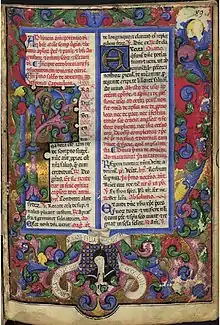
Women's monasteries were different from men's in the period from the 13th to the 16th century. They would shift their order depending on their abbess. If a new abbess would be appointed then the order would change their identity. Every time a monastery would shift their order they would need to replace, correct and sometimes rewrite their texts. Many books survived from this period. Approximately 4,000 manuscripts have been discovered from women's convents from late medieval Germany. Women scribes served as the business women of the convent. They produced a large amount of archival and business materials, they recorded the information of the convent in the form of chronicles and obituaries. They were responsible for producing the rules, statutes and constitution of the order. They also copied a large amount of prayer books and other devotional manuscripts. Many of these scribes were discovered by their colophon.[65]
Despite women being barred from transcribing Torah scrolls for ritual use, a few Jewish women between the thirteenth and sixteenth centuries are known to have copied other Hebrew manuscripts. They learned the craft from male scribes they were related to, and were unusual because women were not typically taught Hebrew. Knowledge of these women scribes comes from their colophon signatures.[66]
Town scribe
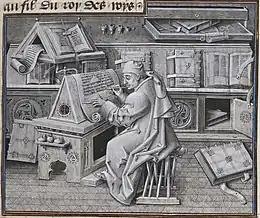
The scribe was a common job in medieval European towns during the 10th and 11th centuries. Many were employed at scriptoria owned by local schoolmasters or lords. These scribes worked under deadlines to complete commissioned works such as historic chronicles or poetry. Due to parchment being costly, scribes often created a draft of their work first on a wax or chalk tablet.[67]
Notable scribes

- Ahmes, 15th Dynasty Egyptian scribe
- Amat-Mamu, Naditu priestess and Babylonian temple scribe
- Amina, bint al-Hajj ʿAbd al-Latif, a Moroccan jurist and scribe
- Baruch ben Neriah, the scribe and friend of the prophet Jeremiah
- Ben Sira, Hellenistic Jewish scribe of the Second Temple period
- Dubhaltach MacFhirbhisigh, 17th-century Irish scribe and Gaelic shcolar
- Ezra, Jewish sofer in the early Second Temple period
- Máel Muire mac Céilechair, a principal scribe of the Lebor na hUidre manuscript
- Metatron, celestial scribe in the angelology tradition
- Poggio Bracciolini, Italian Renaissance scholar known for his humanist script
- Sidney Rigdon, scribe who assisted with the Joseph Smith Translation of the Bible
- Sîn-lēqi-unninni, a Mesopotamian priest and scholar thought to have compiled the best-preserved version of Gilgamesh
- Zayd ibn Thabit, the personal scribe of the prophet Muhammad
Gallery
 Assyrian scribe documenting a battle scene (9th-7th century BCE)
Assyrian scribe documenting a battle scene (9th-7th century BCE)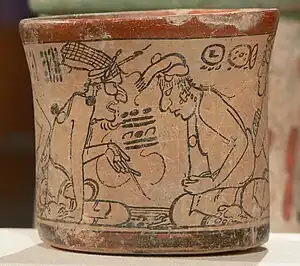 Mayan scribes (550–950 CE)
Mayan scribes (550–950 CE)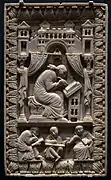 Gregory the Great and scribes (10th century)
Gregory the Great and scribes (10th century)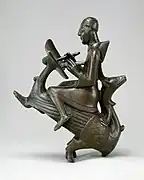 German monastic scribe astride a wyvern (mid-12th century)
German monastic scribe astride a wyvern (mid-12th century)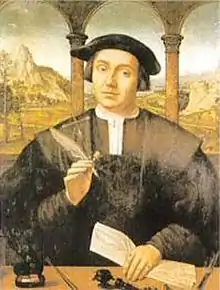
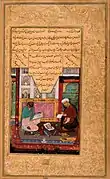 Colophon portrait of Daulat and the scribe 'Abd al-Rahim ("Amber-pen"), from the Khamsa of Nizami (1595–96)
Colophon portrait of Daulat and the scribe 'Abd al-Rahim ("Amber-pen"), from the Khamsa of Nizami (1595–96)
See also
References
- ↑ Harper, Douglas (2010). "Scribe". Dictionary.com. Online Etymology Dictionary. Dictionary.com, LLC. Retrieved 6 June 2017.
- ↑
 This article incorporates text from a publication now in the public domain: Easton, Matthew George (1897). "Scribes". Easton's Bible Dictionary (New and revised ed.). T. Nelson and Sons.
This article incorporates text from a publication now in the public domain: Easton, Matthew George (1897). "Scribes". Easton's Bible Dictionary (New and revised ed.). T. Nelson and Sons.
- ↑ "Women of letters doing write for the illiterate". smh.com.au. Reuters. 12 June 2003. Archived from the original on 26 January 2018. Retrieved 25 January 2018.
- ↑ Rice, Michael (1999). Who's Who in Ancient Egypt. London: Routledge. p. lvi. ISBN 978-0415154482.
- ↑ Damerow, Peter (1996). Abstraction and Representation: Essays on the Cultural Evolution of Thinking. Dordrecht: Kluwer. pp. 188–. ISBN 978-0792338161.
- ↑ Carr, David M. (2005). Writing on the Tablet of the Heart: Origins of Scripture and Literature. Oxford: Oxford University Press. p. 66. ISBN 978-0195172973.
- 1 2 Kemp, Barry J. (2006). Ancient Egypt: Anatomy of a Civilization (2nd ed.). London: Routledge. p. 180. ISBN 978-0415235495.
- ↑ Clarysse, Willy (1993). "Egyptian Scribes Writing Greek". Chronique d'Égypte. 68 (135–136): 186–201. doi:10.1484/J.CDE.2.308932.
- ↑ Budge, E. A. Wallis (1969). The Gods of the Egyptians. New York: Dover Publications. ISBN 978-0486220550.
- ↑ "The Electronic Text Corpus of Sumerian Literature". Etcsl.orinst.ox.ac.uk. 2006-12-19. Retrieved 2017-03-09.
- ↑ "The Electronic Text Corpus of Sumerian Literature". Etcsl.orinst.ox.ac.uk. 2006-12-19. Retrieved 2017-03-09.
- ↑ Kern, Martin (2010). Owen, Stephen (ed.). The Cambridge History of Chinese Literature, vol. 1: To 1375. Cambridge: Cambridge University Press. p. 1. ISBN 978-0-521-85558-7.
- ↑ Keightley, David (1978). Sources of Shang history: the oracle-bone inscriptions of bronze-age China. Berkeley: University of California Press. p. xvi. ISBN 978-0-520-02969-9.
- ↑ Bagley, Robert (2004). "Anyang writing and the origin of the Chinese writing system". In Houston, Stephen (ed.). The First Writing: Script Invention as History and Process. Cambridge University Press. pp. 190–249. ISBN 978-0-521-83861-0.
- ↑ Boltz, William G. (1999). "Language and Writing". In Loewe, Michael; Shaughnessy, Edward L. (eds.). The Cambridge History of Ancient China: From the Origins of Civilization to 221 BC. Cambridge University Press. pp. 74–123. doi:10.1017/CHOL9780521470308.004. ISBN 978-0-521-47030-8. Retrieved 3 April 2019.
- 1 2 Lyons, Martyn (2011). Books A Living History. United Kingdom: Thames & Hudson. pp. 18–20. ISBN 978-0-500-29115-3.
- ↑ Murray, Stuart (2009). The Library An Illustrated History. New York: Skyhorse Publishing. pp. 47–49. ISBN 978-1-60239-706-4.
- ↑ Murray, Stuart (2009). The Library An Illustrated History. New York: Skyhorse Publishing. p. 47. ISBN 978-1-60239-706-4.
- ↑ Lyons, Martyn (2011). Books A Living History. United Kingdom: Thames & Hudson. p. 20. ISBN 978-0-500-29115-3.
- ↑ Selbitschka, Armin (2018). "I Write Therefore I Am: Scribes, Literacy, and Identity in Early China". Harvard Journal of Asiatic Studies. 78 (2): 413–476. doi:10.1353/jas.2018.0029. S2CID 195510449. Retrieved 29 November 2022.
- ↑ Lyons, Martyn (2013). Books: a living history. London: Thames & Hudson. p. 33. ISBN 978-0-500-29115-3. OCLC 857089276.
- ↑ Schniedewind,William M.(2014) UNDERSTANDING SCRIBAL EDUCATION IN ANCIENT ISRAEL:A VIEW FROM KUNTILLET ʿAJRUD.In: MAARAV 21.1–2 pp.272 ff.
- ↑ Werrett, Ian. How Did Scribes and the Scribal Tradition Shape the Hebrew Bible?
- ↑ Metzger, Bruce M.; Coogan, Michael D. (1993). The Oxford Companion to the Bible (1st ed.). Oxford: Oxford University Press. ISBN 9780195046458.
- ↑ Manning, Scott (17 March 2007). "Process of copying the Old Testament by Jewish Scribes". Historian on the Warpath. Retrieved 9 July 2018.
- ↑ Johnson, Paul (1993). A History of the Jews (2nd ed.). London: Phoenix. p. 91. ISBN 978-1857990966.
- ↑
Johnson, Paul (8 August 2013) [1987]. A History of the Jews. Hachette UK (published 2013). ISBN 9781780226699. Retrieved 21 February 2022.
The Dead Sea Scrolls testify, on the whole, to the accuracy with which the Bible was copied through the ages [...].
- ↑ Johnson, Paul (1993). A History of the Jews (2nd ed.). London: Phoenix. p. 91. ISBN 978-1857990966.
- ↑ Schniedewind, William M. (18 November 2008). "Origins of the Written Bible". Nova. PBS Online. Retrieved 9 July 2018.
- ↑ Drazin, Israel (26 August 2015). "Ezra changed the Torah text". Jewish Books. Retrieved 9 July 2018.
- ↑ Okouneff, M. (23 January 2016). Greenburg, John (ed.). The Wrong Scribe: The Scribe Who Revised the King David Story. CreateSpace Independent Publishing Platform. p. 146. ISBN 9781523640430.
- ↑ Gilad, Elon (22 October 2014). "Who Wrote the Torah?". Haaretz. Retrieved 9 July 2018.
- ↑ Marietta Horster, "Living on Religion: Professionals and Personnel," in A Companion to Roman Religion (Blackwell, 2007), p. 334; Daniel Peretz, "The Roman Interpreter and His Diplomatic and Military Roles," Historia 55 (2006), p. 452.
- ↑ David Armstrong, Horace (Yale University Press, 1989), p. 18.
- ↑ Clifford Ando, Imperial Ideology and Provincial Loyalty in the Roman Empire (University of California Press, 2000), p. 96.
- ↑ T.R.S. Broughton, The Magistrates of the Roman Republic (American Philological Association, 1951, 1986), vol. 1, pp. 166–168.
- ↑ T. J. Kraus, "(Il)literacy in Non-Literary Papyri from Graeco-Roman Egypt: Further Aspects of the Educational Ideal in Ancient Literary Sources and Modern Times," Mnemosyne 53:3 (2002), pp. 325–327; Clifford Ando, Imperial Ideology and Provincial Loyalty in the Roman Empire (University of California Press, 2000), p. 101.
- ↑ Peter White, "Bookshops in the Literary Culture of Rome," in Ancient Literacies: The Culture of Reading in Ancient Greece and Rome (Oxford University Press, 2009), p. 269, note 4.
- ↑ Marcus Niebuhr Tod, “A New Fragment of the Edictum Diocletiani,” Journal of Hellenic Studies 24 (1904), pp. 195-202.
- ↑ Nicholas Horsfall, “Rome without Spectacles.” Greece & Rome 42:1 (1995), p. 50.
- ↑ Myles McDonnell, "Writing, Copying, and Autograph Manuscripts in Ancient Rome," Classical Quarterly 46:2 (1996), p. 473.
- ↑ Clarence A. Forbes, "The Education and Training of Slaves in Antiquity," Transactions and Proceedings of the American Philological Association 86 (1955), p. 341.
- ↑ Susan Treggiari, "Jobs for Women," American Journal of Ancient History 1 (1976), p. 78.
- ↑ Chris Keith, "'In My Own Hand': Grapho-Literacy and the Apostle Paul," Biblica 89:1 (2008), pp. 39-58.
- ↑ McDonnell, "Writing, Copying, and Autograph Manuscripts," p. 474.
- ↑ McDonnell, "Writing, Copying, and Autograph Manuscripts," p. 471.
- ↑ George W. Houston, “The Slave and Freedman Personnel of Public Libraries in Ancient Rome,” Transactions of the American Philological Association 132:1/2 (2003), p. 147.
- ↑ McDonnell, "Writing, Copying, and Autograph Manuscripts," p. 473.
- ↑ McDonnell, "Writing, Copying, and Autograph Manuscripts," p. 477.
- ↑ McDonnell, "Writing, Copying, and Autograph Manuscripts," p. 477 "et passim’’.
- ↑ McDonnell, "Writing, Copying, and Autograph Manuscripts," p. 479.
- ↑ McDonnell, "Writing, Copying, and Autograph Manuscripts," p. 478
- ↑ Andrew Garland, “Cicero's Familia Urbana,” Greece & Rome 39:2 (1992), p. 167.
- ↑ Garland, “Cicero's Familia Urbana,” p. 164.
- ↑ Haines-Eitzen, Kim (Winter 1998). "Girls Trained in Beautiful Writing: Female Scribes in Roman Antiquity and Early Christianity". Journal of Early Christian Studies. 6 (4): 629–646. doi:10.1353/earl.1998.0071. S2CID 171026920.
- ↑ "Werken". lib.ugent.be. Retrieved 2020-08-21.
- 1 2 Pavlik, John; McIntosh, Shawn (2017). Converging Media: A New Introduction to Mass Communication. Oxford: Oxford University Press. pp. 66–67. ISBN 9780190271510.
- 1 2 3 Murray, Stuart A.P. (2009). The Library: An Illustrated History. New York, NY: Skyhorse Publishing. pp. 33–34. ISBN 9781602397064.
- 1 2 3 4 Lyons, Martyn (2011). Books: A Living History. Los Angeles: J. Paul Getty Museum. pp. 36–38, 41. ISBN 9781606060834.
- 1 2 Martyn., Lyons (2011). Books : a living history. Los Angeles: J. Paul Getty Museum. ISBN 9781606060834. OCLC 707023033.
- ↑ Lyons, M. (2011). Books: A Living History. Getty Publications.
- ↑ Lady Science (16 February 2018). "Women Scribes: The Technologists of the Middle Ages". The New Inquiry.
- ↑ "Female Scribes in Early Manuscripts". Medieval manuscripts blog.
- ↑ Hall, Thomas N. (Summer 2006). "Women as Scribes: Book Production and Monastic Reform in Twelfth Century Bavaria". The Sixteenth Century Journal. 37: 160–162 – via Gale.
- 1 2 Cyrus, Cynthia (2009). The Scribe for Women's Convents in Late Medieval Germany. University of Toronto Press. ISBN 9780802093691.
- ↑ Riegler, Michael; Baskin, Judith R. (2008). ""May the Writer Be Strong": Medieval Hebrew Manuscripts Copied by and for Women". Nashim: A Journal of Jewish Women's Studies & Gender Issues (16): 9–28. doi:10.2979/nas.2008.-.16.9. ISSN 0793-8934. JSTOR 10.2979/nas.2008.-.16.9. S2CID 161946788.
- ↑ Murray, Stuart A.P. (2009). The Library: An Illustrated History. New York, NY: Skyhorse Publishing. ISBN 9781602397064.
Further reading
- Avrin, Leila (2010). Scribes, Scripts and Books. ALA Publishing. ISBN 978-0838910382.
- Martin, Henri-Jean (1995). The History and Power of Writing. University of Chicago Press. ISBN 0-226-50836-6.
- Tahkokallio, Jaako. (2019). “Counting Scribes: Quantifying the Secularization of Medieval Book Production”. Book History, 22(1), pg. 1-42.
- Richardson, Ernest Gushing (1911). Some Old Egyptian Librarians. Charles Sribners.
External links
- Catholic Encyclopedia. newadvent.org.
.jpg.webp)
_achter_een_voll%E2%80%A6%252C_Bestanddeelnr_255-2339.jpg.webp)